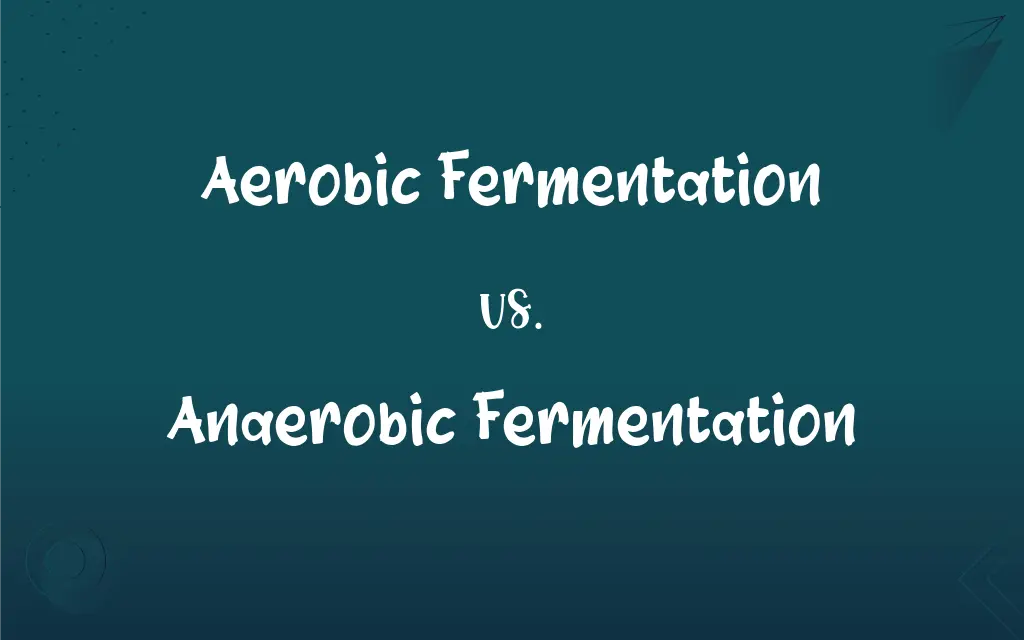Aerobic Fermentation vs. Anaerobic Fermentation: What's the Difference?
Edited by Aimie Carlson || By Harlon Moss || Updated on October 28, 2023
Aerobic fermentation uses oxygen for energy production, while anaerobic fermentation operates without oxygen.

Key Differences
Aerobic fermentation and anaerobic fermentation are biological processes that produce energy from organic substrates. Aerobic fermentation, as implied by its name, requires the presence of oxygen. It's a metabolic pathway where cells generate energy through the breakdown of organic molecules in the presence of oxygen. In contrast, anaerobic fermentation happens without the presence of oxygen. This process is crucial for many microorganisms that live in environments devoid of oxygen.
While aerobic fermentation is generally more efficient than anaerobic fermentation, both processes have their unique advantages. Aerobic fermentation, for instance, produces a significant amount of ATP (adenosine triphosphate), which is a molecule that stores and transfers energy within cells. On the other hand, anaerobic fermentation can quickly generate energy, making it beneficial for rapid responses, even though it yields less ATP compared to its aerobic counterpart.
One distinctive feature of aerobic fermentation is the end products. This process primarily results in carbon dioxide and water. Anaerobic fermentation, however, can lead to various end products, including lactic acid, ethanol, and gases like carbon dioxide, depending on the microorganism and conditions. This variability in anaerobic fermentation products is why we have fermented beverages like beer and wine.
Another important aspect to consider is the organisms that utilize these processes. While many organisms can engage in aerobic fermentation when oxygen is available, certain microorganisms, called obligate anaerobes, can only undergo anaerobic fermentation. They thrive in environments where oxygen is absent or at very low concentrations.
While both aerobic fermentation and anaerobic fermentation are essential for energy production, they also have applications outside of basic cellular function. For instance, the processes are used in biotechnological industries for producing biofuels, fermented foods, and other valuable products.
ADVERTISEMENT
Comparison Chart
Oxygen Requirement
Requires oxygen
Does not require oxygen
ATP Production
Higher
Lower
Typical End Products
Carbon dioxide and water
Varied (e.g., lactic acid, ethanol, CO2)
Efficiency
Generally more efficient
Less efficient
Examples of Utilizing Organisms
Many organisms in the presence of oxygen
Obligate anaerobes and others
ADVERTISEMENT
Aerobic Fermentation and Anaerobic Fermentation Definitions
Aerobic Fermentation
Aerobic fermentation typically produces carbon dioxide and water.
The harmless byproducts of aerobic fermentation are often just CO2 and water.
Anaerobic Fermentation
Anaerobic fermentation quickly generates energy but is less efficient than aerobic methods.
For rapid energy bursts, some cells use anaerobic fermentation.
Aerobic Fermentation
Aerobic fermentation is predominant in oxygen-rich environments.
Oxygen-abundant habitats favor the process of aerobic fermentation.
Anaerobic Fermentation
Anaerobic fermentation is essential for obligate anaerobes.
Obligate anaerobes exclusively use anaerobic fermentation for their energy needs.
Aerobic Fermentation
Aerobic fermentation is an energy-producing pathway requiring oxygen.
Many cells turn to aerobic fermentation when ample oxygen is present.
Anaerobic Fermentation
Anaerobic fermentation plays a significant role in various industrial applications.
From dairy to biofuel industries, anaerobic fermentation is a key process.
Aerobic Fermentation
Aerobic fermentation is generally more efficient than anaerobic processes.
For maximum energy yield, organisms prefer aerobic fermentation when oxygen is accessible.
Anaerobic Fermentation
Anaerobic fermentation is an energy generation process without oxygen.
Certain microbes rely on anaerobic fermentation in oxygen-deprived settings.
Aerobic Fermentation
Aerobic fermentation yields a significant amount of ATP.
Due to aerobic fermentation, cells can produce abundant energy.
Anaerobic Fermentation
Anaerobic fermentation results in varied end products like ethanol or lactic acid.
Beer and wine production takes advantage of anaerobic fermentation.
FAQs
What's the main difference between aerobic fermentation and anaerobic fermentation?
Aerobic fermentation requires oxygen, while anaerobic fermentation does not.
Are the end products of aerobic fermentation and anaerobic fermentation the same?
No, aerobic fermentation typically produces CO2 and water, while anaerobic fermentation can yield varied products like ethanol or lactic acid.
Why is aerobic fermentation considered more efficient?
Aerobic fermentation produces more ATP per molecule of substrate compared to anaerobic fermentation.
Which process, aerobic fermentation or anaerobic fermentation, yields more energy?
Aerobic fermentation generally produces more energy than anaerobic fermentation.
Can a single organism utilize both aerobic fermentation and anaerobic fermentation?
Yes, many organisms can switch between the processes depending on oxygen availability.
Are there specific regions in the human body where anaerobic fermentation is more prevalent?
Yes, muscles during intense exercise often resort to anaerobic fermentation due to limited oxygen supply.
What are common products of anaerobic fermentation?
Common products include ethanol, lactic acid, and carbon dioxide.
Can human cells engage in both aerobic fermentation and anaerobic fermentation?
Yes, human cells can switch between the processes based on oxygen availability and energy demand.
Which fermentation process, aerobic or anaerobic, is used to produce beer?
Beer production uses anaerobic fermentation.
Why do some cells use anaerobic fermentation if it's less efficient?
Anaerobic fermentation can provide rapid energy in environments where oxygen is unavailable.
What's a significant disadvantage of anaerobic fermentation?
It yields less ATP per molecule of substrate compared to aerobic fermentation.
Are there organisms that only use anaerobic fermentation?
Yes, obligate anaerobes rely solely on anaerobic fermentation.
Does aerobic fermentation always need a high concentration of oxygen?
While it requires oxygen, the concentration can vary depending on the organism and conditions.
Which fermentation type, aerobic or anaerobic, leads to muscle soreness after intense exercise?
Anaerobic fermentation in muscles produces lactic acid, which can contribute to muscle soreness.
Can you name an industry that relies heavily on anaerobic fermentation?
The dairy industry, for producing products like yogurt, relies on anaerobic fermentation.
How do cells decide whether to use aerobic fermentation or anaerobic fermentation?
Cells generally base the decision on oxygen availability and their immediate energy needs.
Why is anaerobic fermentation crucial in bread-making?
Anaerobic fermentation by yeast produces CO2, which helps bread rise.
Are the byproducts of aerobic fermentation harmful?
Typically, aerobic fermentation produces harmless byproducts like CO2 and water.
Can aerobic fermentation occur in waterlogged soils?
In waterlogged soils, oxygen is limited, making anaerobic fermentation more prevalent.
In what industrial processes is aerobic fermentation significant?
Aerobic fermentation is essential in industries like waste water treatment and certain biofuel production.
About Author
Written by
Harlon MossHarlon is a seasoned quality moderator and accomplished content writer for Difference Wiki. An alumnus of the prestigious University of California, he earned his degree in Computer Science. Leveraging his academic background, Harlon brings a meticulous and informed perspective to his work, ensuring content accuracy and excellence.
Edited by
Aimie CarlsonAimie Carlson, holding a master's degree in English literature, is a fervent English language enthusiast. She lends her writing talents to Difference Wiki, a prominent website that specializes in comparisons, offering readers insightful analyses that both captivate and inform.































































